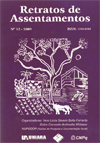Rural Settlements: Unconventional Systems Against Agribusiness
DOI:
https://doi.org/10.25059/2527-2594/retratosdeassentamentos/2009.v12i1.45Abstract
Researches describe a divergence between a highly industrialized agriculture, of large scale, and an unconventional agriculture towards an ecologically more sustainable agriculture (organic, regenerative, ecoagriculture, permaculture, biodynamic, agro-ecology, natural, of extra-sectorial low-input, and so on). The purpose of this work is mapping and debates some critical question as to the environmental and productive agriculture extent, focusing the rural settlements, with no intention to exhaust the subject. It is taking into account the assumption that such matter depicts not just a new scenery of conflicts, but also it presents alternatives, not only among the settled individuals as to the ecological use and management of natural resources within the reformed areas, in opposition to the adopted production systems. The article suggests that rather than fighting the agribusiness practices and its menace to the alimentary autonomy, to the unemployment and biodiversity, it would be better to apply another plan of action.
Keywords: Entrepreneurial Conventional Agriculture; Unconventional Agriculture; Rural Settlements; Productive Systems.
References
ALLEGRETTI, M.H. A Região Amazônica e as atividades extrativas. In:
Clusenet-Godt e Sachs, I. Extrativismo na Amazônia Brasileira.
Perspectivas sobre o Desenvolvimento Regional. Compêndio MAB 18.
UNESCO. 1996.
ALTIERI, M.A. The myth of coexistence: why transgenic crops are not
compatible with agroecologicaly based systems of production. Bulletin of
Science, Technology and Society, Thousand Oaks (California), v.25, n.4,
p.361-371, 2005.
BEUS, C.E.; DUNLAP, R.E. Conventional versus Alternative Agriculture: the paradigmatic roots of the debate. Rural Sociology, Provo (Utah), n.55 (4), p.590-616, 1990.
BROWN. L.R. Seeds of Change: The Green Revolution and development in the 1970´s. New York: Praeger Publishers, 1970.
DENSLOW, J.S. Gap partioning among tropical rain forest trees. Biotropica, Zurich, n.12, p.47-55, 1980.
KAGEYAMA, P.Y. A Biodiversidade como ferramenta em agroecossistemas rurais. Congresso Nacional de Botânica, 2008, São Paulo/SP. In: Anais…, São Paulo, 2008.
KAGEYAMA, P.Y. Establishing small areas in the natural forest to control the disease Mal das Folhas. Congresso Florestal Mundial, 1992, México. In: Anais..., 1992.
KAGEYAMA, P.Y.; GANDARA, F.B.; OLIVEIRA, R.E. Biodiversidade e restauração da Floresta Tropical. In: Restauração Ecológica de Ecossistemas naturais. FEPAF. Botucatu/SP, p.27-48, 2003.
KAGEYAMA, P.Y.; CASTRO, C.F.A.; CARPANEZZI, A.A. Implantação de
matas ciliares: estratégia para auxiliar a sucessão secundária. Simpósio sobre Matas Ciliares, 1989. In: Anais..., Fundação Cargill, 1989.
KRICHER, J. A Neotropical Companion: an introduction to the animals, plants and ecosystems of the New World Tropics. New Jersey (USA): Princeton University Press, 1997.
AZEVEDO, T.R.; LEITE, N.B. O pequeno e médio produtor rural e a nova
dinâmica da silvicultura brasileira. Opiniões, Ribeirão Preto, jun/ago, p.6, 2006.
LEWONTIN, R.C.; BERLAN, R.E. The political Economy of Agricultural
Research: the case of hybrid corn. In: CARROL, C.R.; VANDEMEER, H.;
ROSSET, P.M. Agroecology. New York: Mc Graw Hill, 1990, p.613-628.
MOONEY, P. O Escândalo das Sementes. São Paulo: Nobel, 1979.
RÊGO, J.F. Amazônia: do Extrativismo ao Neo-extrativismo. Ciência Hoje, Porto (Portugal). n.25, p.62-65, 1999.
VEIGA, J.E. Cidades Imaginárias: o Brasil é menos urbano do que se imagina. Campinas/SP: Ed. Autores Associados, 2003.
Downloads
Published
How to Cite
Issue
Section
License
O(s) autor(es) autoriza(m) a publicação do artigo na revista;
• O(s) autor(es) garante(m) que a contribuição é original e inédita e que não está em processo de avaliação em outra(s) revista(s);
• A revista não se responsabiliza pelas opiniões, ideias e conceitos emitidos nos textos, por serem de inteira responsabilidade de seu(s) autor(es);
• É reservado aos editores o direito de proceder ajustes textuais e de adequação do artigo às normas da publicação.
Autores mantêm os direitos autorais e concedem à revista o direito de primeira publicação, com o trabalho simultaneamente licenciado sob a Licença Creative Commons Attribution, que permite o compartilhamento do trabalho com reconhecimento da autoria e publicação inicial nesta revista.
Autores têm autorização para assumir contratos adicionais separadamente, para distribuição não exclusiva da versão do trabalho publicada nesta revista (ex.: publicar em repositório institucional ou como capítulo de livro), com reconhecimento de autoria e publicação inicial nesta revista.
Autores têm permissão e são estimulados a publicar e distribuir seu trabalho online (ex.: em repositórios institucionais ou na sua página pessoal) a qualquer ponto antes ou durante o processo editorial, já que isso pode gerar alterações produtivas, bem como aumentar o impacto e a citação do trabalho publicado (Veja O Efeito do Acesso Livre) em http://opcit.eprints.org/oacitation-biblio.html














